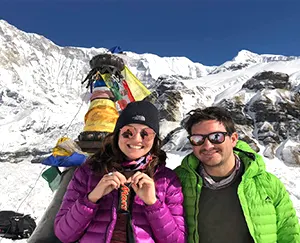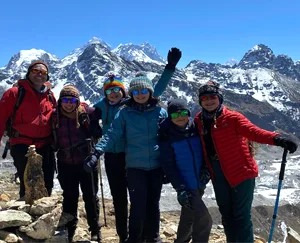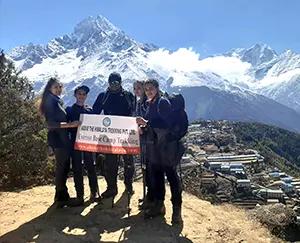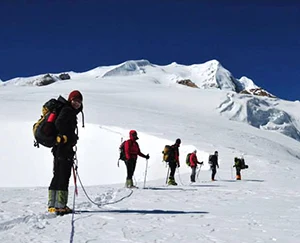Why Choose Muldai View Point Trek Over Poonhill Trek?
There are more than just one reason as to why you should choose the Muldai View Point Trek over Poonhill Trek, especially if you are an adventurer. We get it, not all trekkers have the time or the liberty to spend days on the trails when the priority is high for saving one’s job back home.
But, what can an adventurer do to not risk it all and still go on an adventure in the Himalayan country of Nepal? Go to the Muldai View Point Trek. Muldai View Point Trek has often been compared to the Poonhill trek because of the short distance either of the trek covers.
However, if you go on the Poon Hill trek, you can complete the entire trek within just two days while it takes you from 4 to 5 days to complete the Muldai View Point Trek. And, the adventurous factor is more in the latter destination because you will be stopping by more scenic landmarks.
The following are some reasons why choosing Muldai View Point Trek over Poonhill Trek can be a good decision for you:
Lesser Crowd
When you go on the Muldai View Point Trek, you will find yourself traversing through a lesser crowd. The crowd is usually more on the Poon Hill Trek because it is preferred by adventurers of all age groups, from the oldest to the youngest.
Also, the difficulty level of either treks can be compared to know why one is more crowded than the others. Though bit more difficult than Poon Hill Trek, the Muldai View Point Trek is perfect for those who wants to experience both an adventure of a lifetime and a quick escape.
Elevation Difference
The Muldai View Point Trek takes you to a higher elevation than the Poon Hill Trek. Poon Hill Trek’s highest elevation is 3, 210 m whereas the highest point of Muldai View Point Trek is 3, 637 m above sea level.
Solitude
If you are someone who wants to experience solitude during your journey, you should definitely opt for Muldai View Point Trek rather than Poon Hill Trek because as mentioned before the former is less crowded than the latter location.
View Range
The view range is quite good in Poon Hill trek. When you are in the Muldai View Point Trek, you will get the view of the surrounding at a wider angle, making it more preferable. If you don’t mind trekking an additional hour or two, you can complete both the treks in a single journey when you go on the Muldai View Point Trek.
Trail Type
The Poon Hill trek trails are well worn. You can find yourself comfortably trekking upwards in the stoned stairs as well as the least possible rugged pathways along the Gurung villages in this trek. When you go on the Muldai View Point Trek, you will find yourself immersed in the beauty of secluded forests which are at a bigger distance from habitats as compared to Poon Hill Trek.
Best Time to Go on the Muldai View Point Trek
The best time to go on the Muldai View Point Trek would be spring and autumn. Yet still, each season has something unique to offer to the visitors. From snowy Himalayas to the green panoramic views, and from cultural experience to ease of peaceful trekking even during the cold months, you will experience it all.
The following is a brief description of each season during the Muldai View Point Trek:
Spring
Spring is quite possibly one of the best times you can go on the Muldai View Point Trek. The sky is clear, the air is warm, and you will be able to walk even for several hours without feeling too much cold or sweating too much.
The vegetation and fauna are also blooming and out respectively during this time. Wearing the right kind of trekking clothes does not become an issue. You don’t have to risk too many days of delaying your trek because of the weather favor-ability either.
In addition to this, spring brings about a sense of liveliness in the air. You get to see the most terrific views of the mountains from the time you begin your journey. This is one reason why many photography enthusiasts prefer to visit the Muldai View Point during spring.
Autumn
Autumn is the most preferred season among the four. It is mostly because of the availability of accommodation, weather favorability, visibility, and ease overall. Autumn is neither too hot nor too cold. So, when you are walking for hours, the possibility of dropping on the floor due to tiredness is going to be very low.
The trails are not disturbed by rainwater either. And, there is the least possibility of any natural calamity. Also, you won’t have to face delays unless something exceptional comes up. Though the trails are very peaceful, you may get the chance to interact with a few like-minded trek enthusiasts, which makes your journey exciting.
Locals celebrate the main festivals of Nepal, Dashain and Tihar, during the months of October and November. This can mark a special event between your adventures. Furthermore, autumn offers the best possible visibility as compared to any other season in the year, making it best for photography.
Winter
Though not considered a popular trekking season, winter treks can be exciting and, to an extent, very comfortable. The Muldai View Point Trek does not carry any threats because it is a moderately challenging journey. You won’t necessarily pass trails that are snowy either.
The crowd will be minimal during the winter season. You may experience solidarity on a different, more impressive level in this season. One of the best features of winter is that you will get the clearest view of the mountains, regardless of where you are in your journey, because of clear skies.
There is a possibility of snowfall in Dobato and Muldai. But if you are well-equipped and prepared for the minor challenges, even the snowfall can become an experience to cherish. Besides this, walking through the 4 to 5 days long trails won’t be very difficult as the weather is mostly on the chillier side during the days.
Summer/ Monsoon
Summer and monsoon are not very preferable for trekking journeys. However, since the Muldai View Point Trek is not considered the most difficult trek, you may still enjoy your time along the trails. Unexpected rainfall and delays of trekking days might be tad bit of an issue sometimes.
The forests can give off a mystical and cleansing vibe after rain. Walking through the smell of freshly wet soil and foggy mountains can be an exceptionally good and unique experience. Leeches may be a problem due to rain.
You may not be able to take the best pictures of the mountain. When it rains, the trails will be slippery and somewhat dangerous. So, going well prepared and equipped is more than necessary. Even if you are planning to trek during summer time, you may want to go there before monsoon comes in.
That said, off seasons usually also make journeys more affordable for the trekkers because flight tickets and accommodation are not as pricey as they are during peak months. Another upside of trekking during summer time is tranquility.
What Types of Trekkers is The Muldai View Point Trek Most Suitable For?
Trekkers are usually curious as to what types of trekkers are most suited for certain trekking destinations, including the Muldai View Point. The moderately challenging, yet somewhat simple trek is most suitable for the following types of trekkers:
Beginner Level Trekkers
Trekkers who are beginner level can be suitable for this trek. The trek is not very difficult and won’t take one very long to complete. If you have gone to few hikes and some short treks before, you can complete this trek without much trouble. Regardless, it is recommended that you come with proper physical and mental preparation.
Time Conscious Trekkers
Life can get very busy when you are juggling work and personal life with recreational activities like trekking. If you time conscious but want to relax at least even a few days away from your busy life, the Muldai View Point Trek, from beginning till the end can be very suitable for you.
Nature Enthusiasts
Anyone who loves the nature and wish to stay out for days can opt for this trek. One best thing about this trek is that, you can extend it up to a week or few days more than even that. Trekkers will be trekking through green hills and views of bluish white mountains below blue sky. Along the way, you will also pass lots of colors and small waterways which makes the natural trails even more appealing.
Cultural Explorers
If you love exploring different cultures, you will love the vibe and the experience of the Muldai View Point Trek. This journey is perfect for those who love eating food from different cuisine, celebrating different festivals, and simply knowing about the lifestyle of people from remote and unique traditional backgrounds like Gurung and Magar.
Solo Trekkers
Solo trekkers who love peace yet want to stay safe can opt for the Muldai View Point Trek. You can always take along a reliable guide with the help of your trekking agency to ensure your safety. This does not necessarily mean that you need a whole bunch of people around you as you relish on the beauty of the villages, forests, or the viewpoint.
Small Groups
While many treks require bigger groups to partake for safety and ease, Muldai View Point Trek is perfect for smaller groups. This not only means that you will be trekking in peace, it also means that your friend group can finally take on the adventure you had long been keeping in your wish list, without hassle or worry.
Families
Families with older children can go on this trek. Usually, treks on a difficult level aren’t suitable for families. The Muldai View Point Trek makes families make memories in the nature even though the journey lasts for days. Whether you are someone aged 50 or someone aged 18, you’re well suited for this trek.
Birdwatchers and Wildlife Enthusiasts
There are many wildlife enthusiasts and birdwatchers who go on the Muldai View Point Trek each year, usually during spring season. The variety of wildlife creatures and bird species including pheasants, rufous sibia, Himalayan monal, red panda, etc. are rare yet fascinating sights perfect for photography or even just close sightings.
What Are The Challenges And Risks Involved in Muldai View Point Trek
While there are plenty of advantages of trekking to the Muldai View Point even as a beginner, there are some challenges that may come your way. Some such risks or challenges are as follows:
Weather Condition
The weather condition mostly depends on the season that you’re trekking in. If you are trekking during summer or monsoon, or winter season, the chances of slippery trails and windy surroundings will likely cause delays.
The trails are generally safe, but panic or rushing may cause minor accidents. These challenges are not very likely, but you still need to pay attention to the chances of dangers as such regardless.
Physical Fitness Challenges
You need to be physically fit if you want to complete this trek. Most trekkers come unprepared which makes it tough for them to continue the journey without extending days. Days spent on preparing yourself physically mostly with cardio, short hikes around your locality, and jogging can help you become fitter for the trek.
Facilities
The Muldai View Point Trek has limited facilities, though it covers all the basic requirements of trekkers. Facilities are least likely to become an issue for someone who has been trekking for a while. Any new trekker may find a lack of luxury a bit of a hassle, especially if they have not been to a slightly remote trek before.
Altitude Sickness
Altitude sickness is not uncommon during the Muldai View Point Trek. The chances are very less. Still, if you do not walk in tune with your breathing, you may suffocate. You need to rest in between your walks and drink enough water to avoid suffering from altitude sickness. Rushing to get to the viewpoint can often cause such a problem.
What to Bring to the Muldai View Point Trek
Clothing
- Warm jacket (down or fleece)
- Rain jacket
- Quick dry t-shirts
- Trekking pants
- Thermal underwear
- Warm hat
- Sun hat or cap
- Lightweight gloves
- Socks
- Undergarments
Footwear
- Trekking boots
- Slippers or sandals
Bags
- Backpack
- Small daypack
- Rain cover for backpack
Sleeping & Hygiene
- Sleeping bag
- Toothbrush & toothpaste
- Small towel
- Toilet paper
- Hand sanitizer
- Basic soap
- Wet wipes
Water & Snacks
- Water bottle or hydration bladder
- Water purification tablets or filter
- Some energy bars, nuts, or chocolates
Health & Safety
- Sunscreen
- Lip balm
- Basic first aid kit (band-aids, painkillers, etc.)
- Any personal medicine
- Headlamp or flashlight (with extra batteries)
Extras
- Camera or phone
- Power bank
- Trekking poles
- Notebook/pen
- Some cash (ATMs not available on the trail)
Sunrise View at the Muldai View Point Trek: What You Need To Know
Watching the sun rise at 3,637 meters and get a 360 degree view of the surrounding from that height can be a heavenly feeling. Before you take on the trek up to the viewpoint, the following are what all you need to know about the Muldai View Point:
What Makes Sunrise at the Muldai View Point Trek So Special?
When you’re at the Muldai View Point Trek, you will get to see around 25 peaks. These peaks include Annapurna South, Nilgiri, Dhaulagiri, Tukuche, Machhapuchhre, and Hiuchuli. One of the main factor that makes the view stand out in the earliest hour of the day is the rosy, organish glow behind the mountains which is perfect for photography.
And, unlike Poon Hill’s viewpoint that is usually very crowded, the Muldai View Point is not crowded. This gives you more time to take in the beauty of the sunrise and the surrounding mountains without being bothered, especially if you are into photography.
When to Start the Muldai View Point Trek?
Trekkers are suggested to start the Muldai View Point Trek at the earliest hour of the day. The preferable hours would be around 5: 30 am. Why so early? Because the climb can be very steep and it is best to go slow and comfortably by starting the day early. Don’t forget to carry a headlamp of a torch light!
Photography Tips
The following are the tips you need to follow if you are a photographer trekking to the Muldai View Point:
- Carry a Camera with Zoom: Carrying a camera with zoom can help you capture minute details of the sunrise and the morning skies amid the snow capped mountains. If you don’t own a camera, getting a phone with the perfect night view setting can be helpful for the perfect shot.
- Bring a Tripod: You don’t have to waste too much time and efforts setting angles when you bring a tripod. A tripod is mostly useful if you plan to capture timelapses and long exposures.
- Wait 10 to 20 minutes before and after sunrise: Trekkers will get the best view of the sunrise 10 to 20 minutes before and after it happens. The view is mostly a mixed color of pink, orange, yellow, and red.
- Take pictures of outlines: Taking pictures of the outlines of objects and people during sunrise can result to a very aesthetic outcome. It is highly suggested to experiment a little with shadows when you can.
How to Catch Sunrises in Both Muldai View Point and Poon Hill?
Trekkers can catch sunrises in both Muldai View Point and Poon Hill by setting the itinerary accordingly. It is possible for you to catch sunrises in both the locations in both 4 days long itinerary and 5 days long itinerary.
On day 3 of your Muldai View Point Trek, you can go to the Muldai View Point. Right on day 4 of the trek, after having descended to Ghorepani the day before, you can begin your short Poon Hill Trek.
Checklist To Keep In Mind During The Muldai View Point Trek
Though there isn’t much for one to do during the Muldai View Point Trek, the following checklist can help you complete the journey with much convenience:
- Wake up early: While you still have the option to wake up late, don’t do it if you don’t want to miss out on the perfect view of sunrise. Wake up as early as 4: 30 am or at least 5:00 am in the morning for the best possible scenery when you’re atop.
- Charge your phones: Charging your phones can be beneficial when you are on the Muldai View Point Trek. This will let you take as many pictures and videos as you want, and you won’t miss out on anything important either.
- Dress warmly: Trekkers should dress warmly. No matter the season, the air is going to be very chilly in the morning. Wearing gloves, caps, and mufflers is also suggested.
- Carry a headlamp: Carrying a headlamp during your morning trek will let you track your ways without tripping on the way.
- Don’t trash: Trashing is toxic. Be sure to practice eco-friendly trekking when you visit the beautiful Muldai View Point.
- Carry snacks and water: You may not find snacks and water wherever you want during this trek. Be sure to carry a water bottle with enough water purification tablets and some snacks.
- Relax and enjoy: Last but not the least, don’t forget to relax and enjoy the trek. Make sure to make your trek worthwhile by simply taking in the view joyfully.
Guided Trek Vs. Solo Trek: Muldai View Point Trek
Trekkers should consider going on the trek that best matches their taste, whether it is guided or solo. One of the best things about the Muldai View Point Trek is that, you get to make the choice as to which kind of trek you can go to.
The following points will help you decide what’s more suitable for you:
Guided Muldai View Point Trek
There are many reasons why you should go on a guided Muldai View Point Trek, mostly if you’re a beginner trekker. Firstly, it is very safe to trek with at least 2 to 5 people in a group. Secondly, you can even opt for guide support if you are not confident about the routes and have never been on a trek before.
Another best thing about Muldai View Point Trek is that, you will be splitting bills wherever you are going. This makes for a more affordable trek. You will also be supporting local economy because someone will be handling your logistics and bookings. Cultural interactions also become simpler.
Solo Muldai View Point Trek
If you are someone who likes solidarity more than you do group settings, then you should go on a solo Muldai View Point Trek. You will have more freedom during the trek when you’re budgeting and deciding on extension of the journey.
A beginner level solo trekker is suggested to take along a guide and a porter for extra ease and security. Don’t forget to be mindful about the possible challenges when you are trekking alone, even if the trek is simpler than most others. Another good thing about solo trekking is that, you may spend lesser than you would in a group setting.
Nearby Attractions During The Muldai View Point Trek
There are a few locations that you can choose to visit during the Muldai View Point Trek as an extension. You don’t have to go through excessive hassle because the Above The Himalayas team will handle the extension and logistics smoothly.
The following are a bunch of other locations close to the Muldai View Point that you can explore:
Poon Hill
The Poon Hill trek, lasting around 2 hours back and forth, is a very popular option, just like we’ve mentioned before. This journey begins at Ghorepani village and ends here. You don’t have to spend a day more on extending the journey when you plan to go to Poon Hill. Though the viewpoint is at a lower elevation, the beauty is exceptional.
Khopra Danda
You need to set aside at least 3 to 4 extra days if you are looking to extend your Muldai View Point Trek to visit Khopra Danda. The trek takes you from 2 to 4 days for completion. When you’re in this trek, you can also choose to visit the sacred Khapra lake at an elevation of 4,650 m. You will get a close glimpse of Annapurna South and Fang during this trek.
Annapurna Base Camp
With an addition of 4 to 5 days to your Muldai View Point Trek, you can visit the Annapurna Base Camp. Your journey will begin from Tadapani, and you will be descending to Chhomrong before you start your ABC journey. This trek is perfect for those who wants to go on a high altitude trek. Your route includes Bamboo, Deurali, and the Modi Khola river valley.
Hot springs (Jhinu Danda)
You can visit a natural hot spring at Jhinu Danda by extending your trek by 1 to 2 hours only. We recommend you visit Jhinu Danda after having completed the trek because you will get the opportunity to relax after days of becoming sore. In a gist, Jhinu Danda visit is perfect for couples, post trek relaxation, and a quick spa in the natural hot spring.
Conclusion
The Muldai View Point Trek is short but rewarding trek meant for all kinds of trekkers. At an elevation above 3000m, everything will seem far away from the urban noise and busy vibes. Other than that, this is one trek that advanced level trekkers can enjoy when they want some time off from their daily lives and beginner can enjoy as a new adventure.
You will also be helping locals in making their income by hiring guides and staying in accommodation that are run by Gurung and Magar locals. The experience is going to be very authentic. To book your trek today, contact us at Above The Himalayas for the best trekking experience!
![]() General
General![]() Preparation & Fitness
Preparation & Fitness![]() Permits
Permits![]() Insurance and Visa
Insurance and Visa![]() Guides & Support Staff
Guides & Support Staff![]() Accommodation and Facilities
Accommodation and Facilities![]() Food and Drinks
Food and Drinks![]() Weather & Seasons
Weather & Seasons![]() Health & Safety
Health & Safety![]() Packing & Gear
Packing & Gear![]() Booking & Payment
Booking & Payment![]() Transportation & Flight
Transportation & Flight Enjoy Himalayan scenery with the help of Nepal’s best guides with Government license holders and got training in first-aid, our Trip Leaders, know where you’ll find the best photos, most fascinating wildlife, and the best stream crossings.
Enjoy Himalayan scenery with the help of Nepal’s best guides with Government license holders and got training in first-aid, our Trip Leaders, know where you’ll find the best photos, most fascinating wildlife, and the best stream crossings.
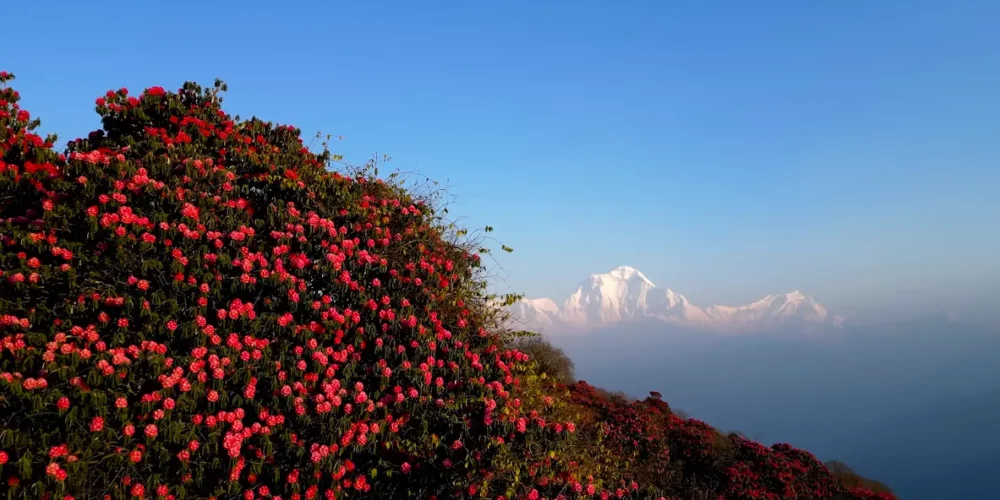




 Have Questions?
Have Questions?